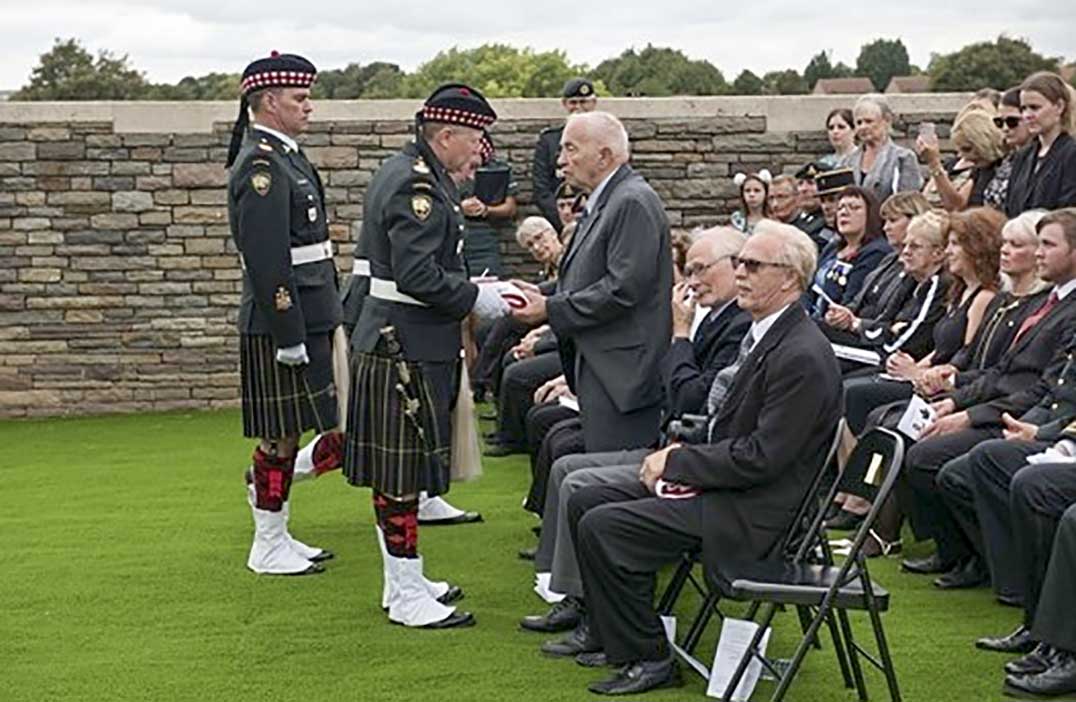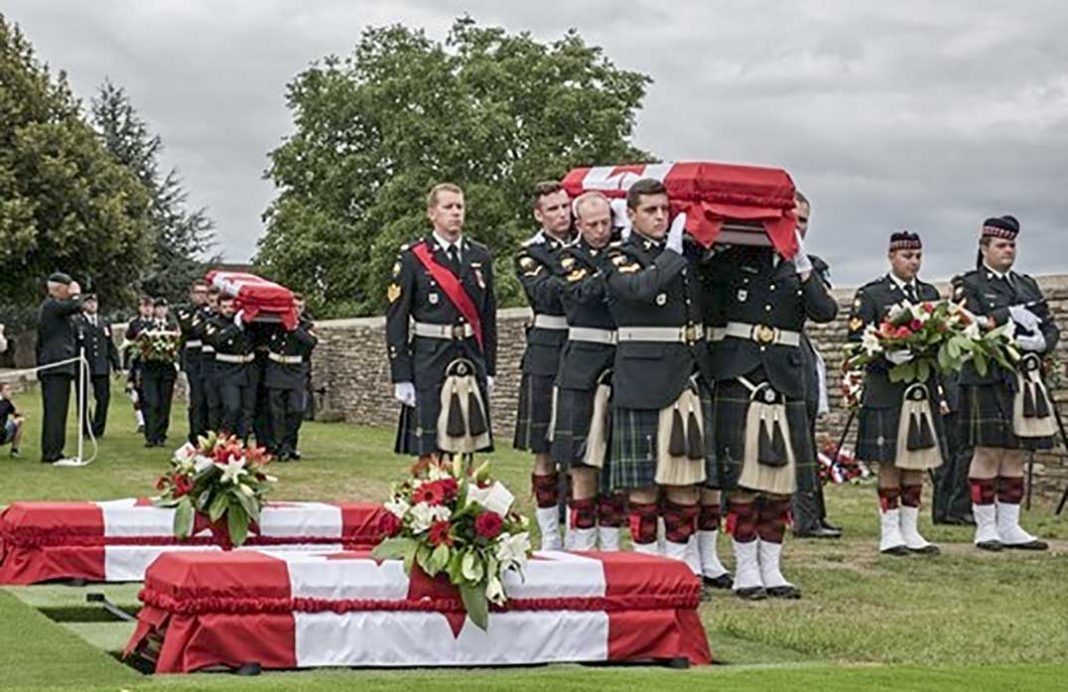INGERSOLL—Four Canadian soldiers from the First World War, including Private Henry Edmonds Priddle, who has family on Manitoulin (including Gore Bay), were laid to rest on Thursday, August 23 with military honours at the Commonwealth War Graves Commission’s (CWGC) Loos British Cemetery outside Loos-en-Gohelle, France. The families of the four soldiers were in attendance, with the support of Veterans Affairs Canada.
“We are grateful for the support of our international partners who made today’s events possible,” said Harjit S. Sajjan, Canadian Defence Minister. “As we mark this year the 100th anniversary of the end of the First World War, we remember and honour these four soldiers and the nearly 61,000 other brave Canadians who gave their lives in the defence of Canadian values in that horrible conflict. Their sacrifice will never be forgotten.”
Seamus O’Regan, Veterans Affairs Minister and Associate Minister of National Defence said, “a century ago and half a world away, these soldiers gave so much for our country and we must remember their service and honour their sacrifices. To the families of Sergeant Wilson, Private Donegan, Private Priddle and Private Thomas, Canada stands with you as your loved ones receive the dignified burial they are truly deserving of.”
Private Priddle is the great uncle of Molly Anne McLauglin of Gore Bay, as well as Margaret Murray of Ingersoll, who attended the ceremony with her daughter Catharine Manicom (a Guelph resident), and her cousin Gerald Hanley.
“It was a really, really special service,” said Ms. Murray on Sunday. “They treated us and the fallen soldiers like royalty.” She said, “the night before the service, several French-Canadian soldiers and the Major General from Canada shook our hands and introduced themselves, prior to all of us going to supper. At the service, the Major General from Canada walked beside me when we were walking behind the casket.”

Henry Edmonds Priddle (who has relatives on Manitoulin Island), receives a folded Canadian flag during the burial for the First World War soldiers, who lost their lives during the Battle of Hill 70, at Loos British Cemetery, Loos-en-Gohelle, France on August 23.
“It was a wonderful, emotional ceremony,” said Ms. Murray. She said soldiers carried the caskets over their shoulders, then put caskets in the opening, standing at attention throughout the service, which lasted about an hour. Everyone then enjoyed lunch at the town hall.”
“Then two or three hours later we all went back to put Canadian flags on the four soldiers’ headstones,” continued Ms. Murray. “It was such a beautiful, colourful ceremony,” she said, noting, “a padre from my community who attended the ceremony as well spoke briefly. He had led the caskets being brought in. As part of the ceremony I also laid a wreath in front of Henry Priddle’s casket-headstone,” said Ms. Murray.
“My cousin Gerald (Hanley), who is six months older than I am, was presented a box with Henry’s remaining artifacts, the Canadian flag that had been folded up after having been set on Henry’s headstone,” said Ms. Murray. “One of these days we are going to get together and look after the artifacts, and Gerald is going to be putting all the artifacts in the St. Thomas Museum.” She noted that “one of the artifacts was a hornet bugle that Henry (Priddle) played, and other items.”
Ms. Murray said, “it was an emotional service. The caskets that held the remains of each of the soldiers carried about 75 percent of his remains. The caskets were all dark wood and must have cost Veterans Affairs a lot of money.”
On May 22, 2018, the Department of National Defence (DND) and the Canadian Armed Forces (CAF) announced the identification of the remains of three Canadian soldiers from the First World War found near the village of Vendin-le-Vieil, France, as Private William Del Donegan, 20, Private Henry Edmonds Priddle, 33, and Sergeant Archibald Wilson, 25. All three soldiers enlisted in Winnipeg, Manitoba. They died on August 16, 1917, in the Battle of Hill 70, as members of the 16th Canadian Infantry Battalion (The Canadian Scottish) and the Canadian Expeditionary Force (CEF), a unit perpetuated by The Canadian Scottish Regiment (Princess Mary’s) of Victoria, B.C.
On May 28, 2018, DND and the CAF announced the identification of the remains of a fourth Canadian soldier from the First World War, found at the site of a construction project in Lens, France, as Private John (Jack) Henry Thomas, of Chewale, South Wales, UK and Birch Ridge, New Brunswick. Private Thomas was a member of the 26th Canadian Infantry Batallion (New Brunswick), CEF, a unit perpetuated by The Royal New Brunswick Regiment of Frederiction, New Brunswick. He died on August 19, 1917, at the age of 28 in the Battle of Hill 70.
As was reported previously, Private Henry Edmonds Priddle, “is my great uncle, being my grandfather (William Priddle’s) brother,” Molly Anne McLaughlin of Gore Bay told The Recorder. She pointed out, “most of the Priddles are in southern Ontario and Henry was from Norwich, Ontario. He was in Manitoba when he signed up for the Forces, but had been in Norwich most of his life.”
Mrs. McLaughlin told the Recorder, “a few days before Christmas I had got a call from the Department of Defence on this. I knew Uncle Henry had been in World War One but I didn’t know he hadn’t been found.” She acknowledged, “it was sort of a weird feeling. As I said, I thought he had died in the war, but I never knew his remains had never been found.”
“I understand his remains were actually found in 2011,” said Ms. McLaughlin, “but it had taken this long to identify the remains. I understand a building in France was being demolished and the remains of three Canadian soldiers were found, including my great uncle.”
“Margaret Murray is a distant first cousin of mine, is 84 and lives in Ingersoll,” Ms. McLaughlin told The Recorder previously. “She and her daughter Catherine will be attending the service.” She pointed out Henry Priddle’s name was on the Vimy Ridge monument.
“My father Frank Priddle, who was also in the Canadian Forces in World War I, he would be Henry’s nephew,” said Ms. McLaughlin. “My Dad was a private. Dad joined the forces when he was 20, Henry enlisted at the age of 31.”
Private Henry Edmonds Priddle was born on May 17, 1884, in Norwich, Ontario. In 1910 he married Florence Hazen, and the couple settled in Winnipeg. Private Priddle worked as a broom-maker before enlisting in the CEF on April 1, 1916, at age 31. He joined the 16th Battalion CEF in France on May 9, 1917, and died on August 16, at the age of 33 during the Battle of Hill 70.
The Battle of Hill 70 took place August 15-25, 1917. It was the first major action fought by the Canadian Corps under a Canadian Commander in the First World War. Approximately 2,100 Canadians gave their lives in the battle, over 1,300 of whom have no known grave. The strategic high point of Hill 70 remained in Allied hands until the end of the war.
Henry Priddle was Mrs. Murray’s great uncle. “No, I didn’t really know anything about him,” she told The Recorder previously. “I know he played the clarinet and I used to play the clarinet as well.”
“I know he was born and raised in Norwich, Ontario and moved to Winnipeg,” said Ms. Murray. “He was my mother (Jean Reeves)’s uncle. “
“My husband’s uncle was also killed in World War I and our hotel in France is a half an hour from where we are staying so we will also be putting a flag on the headstone of William John Bagley (as will be the case for Mr. Priddle’s headstone),” said Ms. Murray.
“The courage of these four brave soldiers and the families who supported them paved the way for victory in the First World War,” said Lieutenant-General Charles Lemaire, Commander Military Personnel Command. “We honour their selfless sacrifices, and we will never forget what they gave for Canada. Today’s ceremony also demonstrates that Canada will always remember and honour the sacrifices of those who have served.”
Mr. David Kettel, Brigadier-General (Ret.), Secretary General, the Canadian Agency of the Commonwealth War Graves Commission said, “although many years have passed since they were lost, it is meaningful to give these soldiers the dignity and respect of a military burial in a Commonwealth cemetery. Their sacrifice will never be forgotten.”
DND’s Casualty Identification Program aims to identify unknown soldiers when their remains are discovered, so that they may be buried with a name, by their regiment and in the presence of their family. The program fosters a sense of continuity and identity within the CAF by providing an opportunity for all Canadians to reflect upon the experiences of those women and men who have made the ultimate sacrifice for their country.
The Casualty identification Program’s Casualty Identification Review Board, which includes participants from the Canadian Forces Forensic Odontology Response Team and the Canadian Museum of History, confirmed the identity of the four soldiers through historical, genealogical, anthropological and DNA analysis.






